Project Management: A Comparison of Agile, Waterfall & the PLC
VerifiedAdded on 2023/06/10
|6
|1161
|102
Report
AI Summary
This report defines project management methodology and its role, comparing Agile and Waterfall methodologies, highlighting similarities, differences, and their relation to the Project Life Cycle (PLC). It discusses the importance of methodologies in effective decision-making, controlled project scope, risk management, and providing strategic benefits. The report explains how both methodologies share basic execution principles but differ in their approach to project phases, flexibility, and requirements management. Finally, it connects both methodologies to the PLC's conceptualization, planning, execution, and termination phases, underlining their applicability in various project scenarios. Desklib provides access to this and many other solved assignments for students.
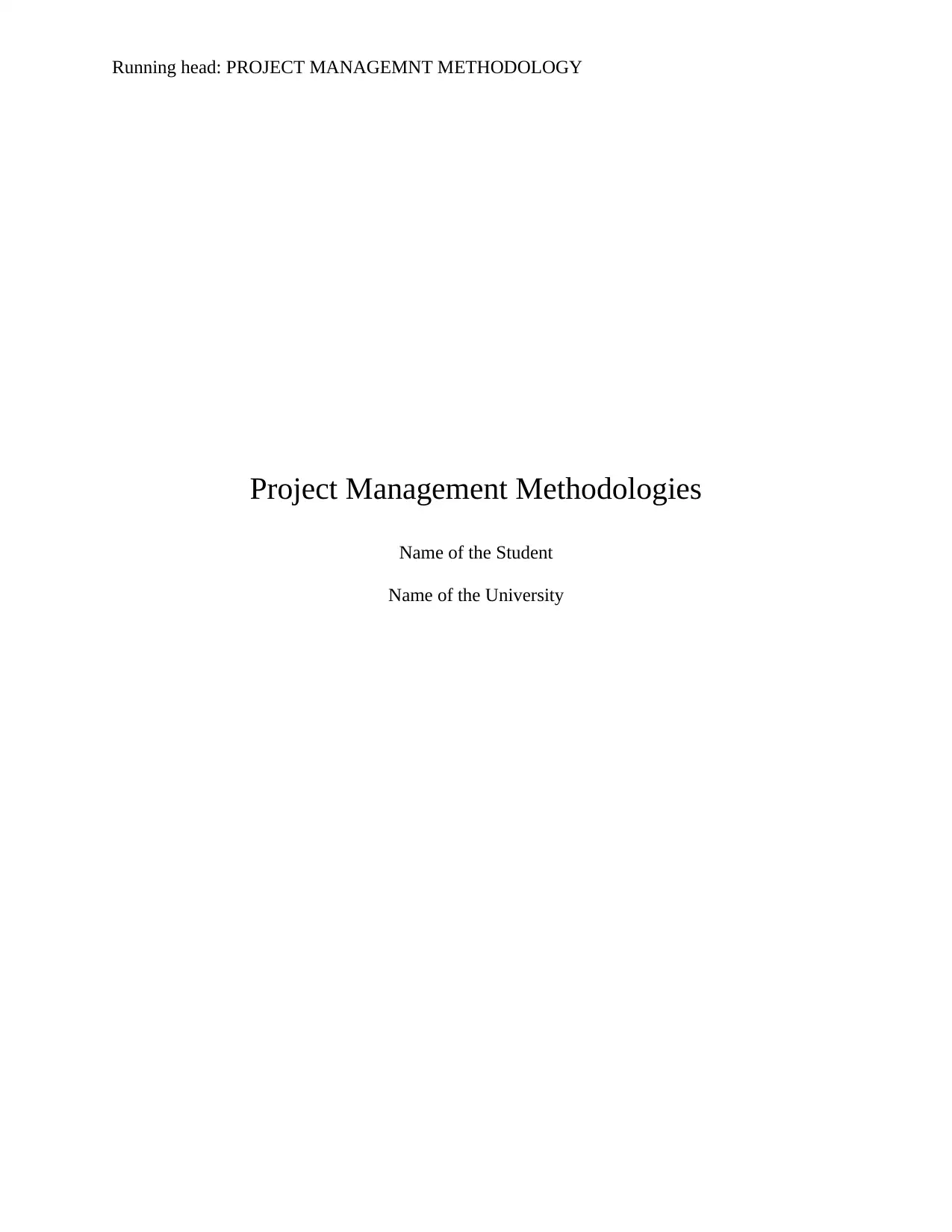
Running head: PROJECT MANAGEMNT METHODOLOGY
Project Management Methodologies
Name of the Student
Name of the University
Project Management Methodologies
Name of the Student
Name of the University
Paraphrase This Document
Need a fresh take? Get an instant paraphrase of this document with our AI Paraphraser
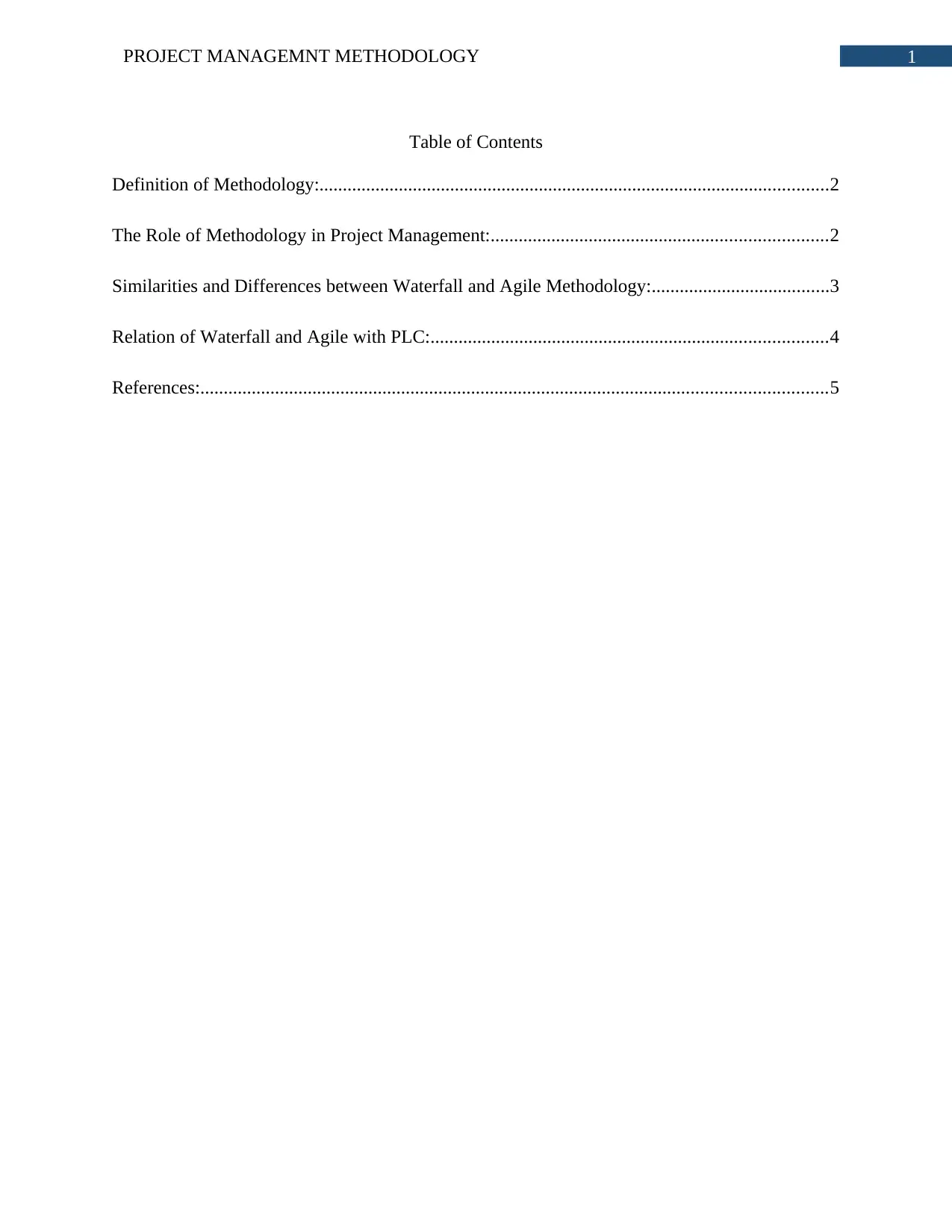
1PROJECT MANAGEMNT METHODOLOGY
Table of Contents
Definition of Methodology:.............................................................................................................2
The Role of Methodology in Project Management:........................................................................2
Similarities and Differences between Waterfall and Agile Methodology:......................................3
Relation of Waterfall and Agile with PLC:.....................................................................................4
References:......................................................................................................................................5
Table of Contents
Definition of Methodology:.............................................................................................................2
The Role of Methodology in Project Management:........................................................................2
Similarities and Differences between Waterfall and Agile Methodology:......................................3
Relation of Waterfall and Agile with PLC:.....................................................................................4
References:......................................................................................................................................5
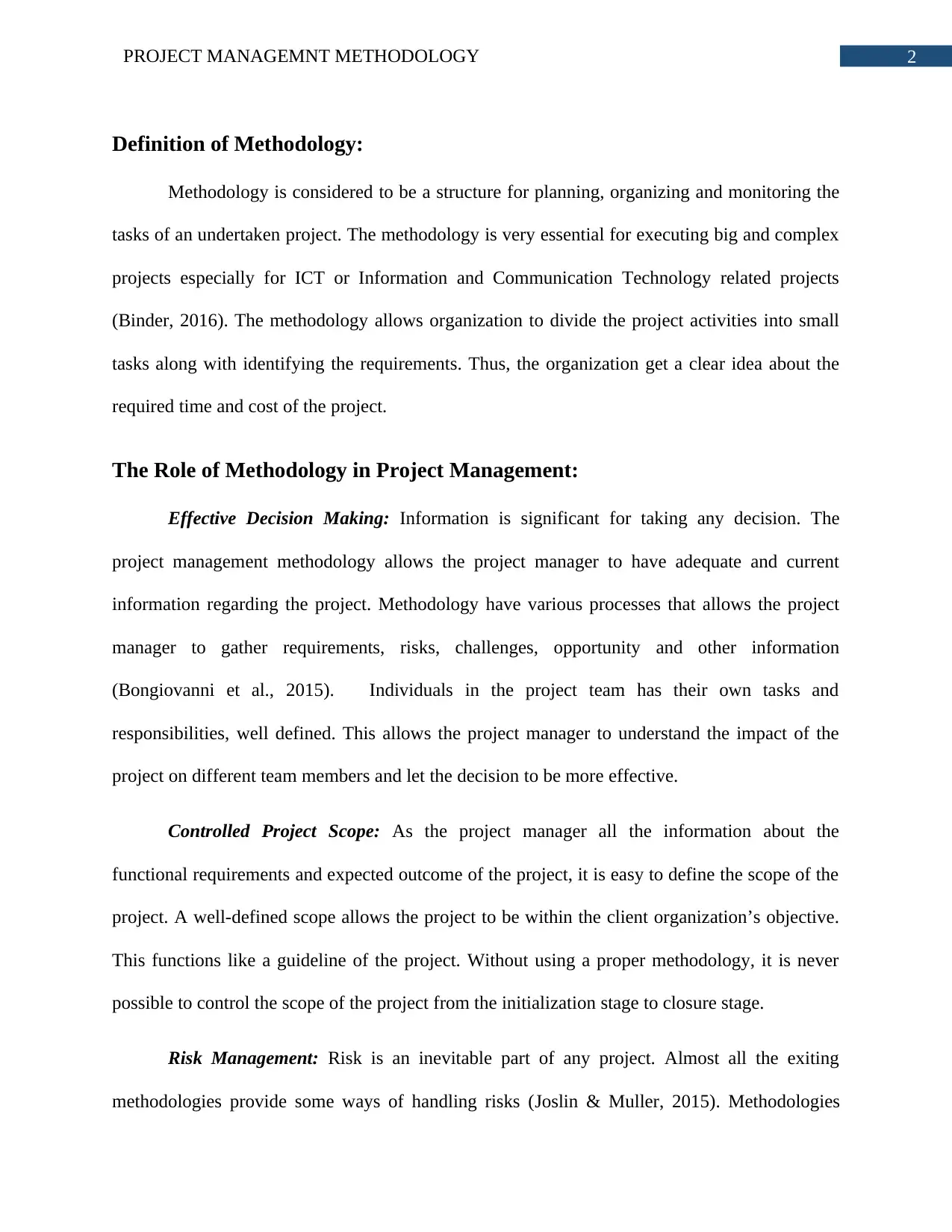
2PROJECT MANAGEMNT METHODOLOGY
Definition of Methodology:
Methodology is considered to be a structure for planning, organizing and monitoring the
tasks of an undertaken project. The methodology is very essential for executing big and complex
projects especially for ICT or Information and Communication Technology related projects
(Binder, 2016). The methodology allows organization to divide the project activities into small
tasks along with identifying the requirements. Thus, the organization get a clear idea about the
required time and cost of the project.
The Role of Methodology in Project Management:
Effective Decision Making: Information is significant for taking any decision. The
project management methodology allows the project manager to have adequate and current
information regarding the project. Methodology have various processes that allows the project
manager to gather requirements, risks, challenges, opportunity and other information
(Bongiovanni et al., 2015). Individuals in the project team has their own tasks and
responsibilities, well defined. This allows the project manager to understand the impact of the
project on different team members and let the decision to be more effective.
Controlled Project Scope: As the project manager all the information about the
functional requirements and expected outcome of the project, it is easy to define the scope of the
project. A well-defined scope allows the project to be within the client organization’s objective.
This functions like a guideline of the project. Without using a proper methodology, it is never
possible to control the scope of the project from the initialization stage to closure stage.
Risk Management: Risk is an inevitable part of any project. Almost all the exiting
methodologies provide some ways of handling risks (Joslin & Muller, 2015). Methodologies
Definition of Methodology:
Methodology is considered to be a structure for planning, organizing and monitoring the
tasks of an undertaken project. The methodology is very essential for executing big and complex
projects especially for ICT or Information and Communication Technology related projects
(Binder, 2016). The methodology allows organization to divide the project activities into small
tasks along with identifying the requirements. Thus, the organization get a clear idea about the
required time and cost of the project.
The Role of Methodology in Project Management:
Effective Decision Making: Information is significant for taking any decision. The
project management methodology allows the project manager to have adequate and current
information regarding the project. Methodology have various processes that allows the project
manager to gather requirements, risks, challenges, opportunity and other information
(Bongiovanni et al., 2015). Individuals in the project team has their own tasks and
responsibilities, well defined. This allows the project manager to understand the impact of the
project on different team members and let the decision to be more effective.
Controlled Project Scope: As the project manager all the information about the
functional requirements and expected outcome of the project, it is easy to define the scope of the
project. A well-defined scope allows the project to be within the client organization’s objective.
This functions like a guideline of the project. Without using a proper methodology, it is never
possible to control the scope of the project from the initialization stage to closure stage.
Risk Management: Risk is an inevitable part of any project. Almost all the exiting
methodologies provide some ways of handling risks (Joslin & Muller, 2015). Methodologies
⊘ This is a preview!⊘
Do you want full access?
Subscribe today to unlock all pages.

Trusted by 1+ million students worldwide
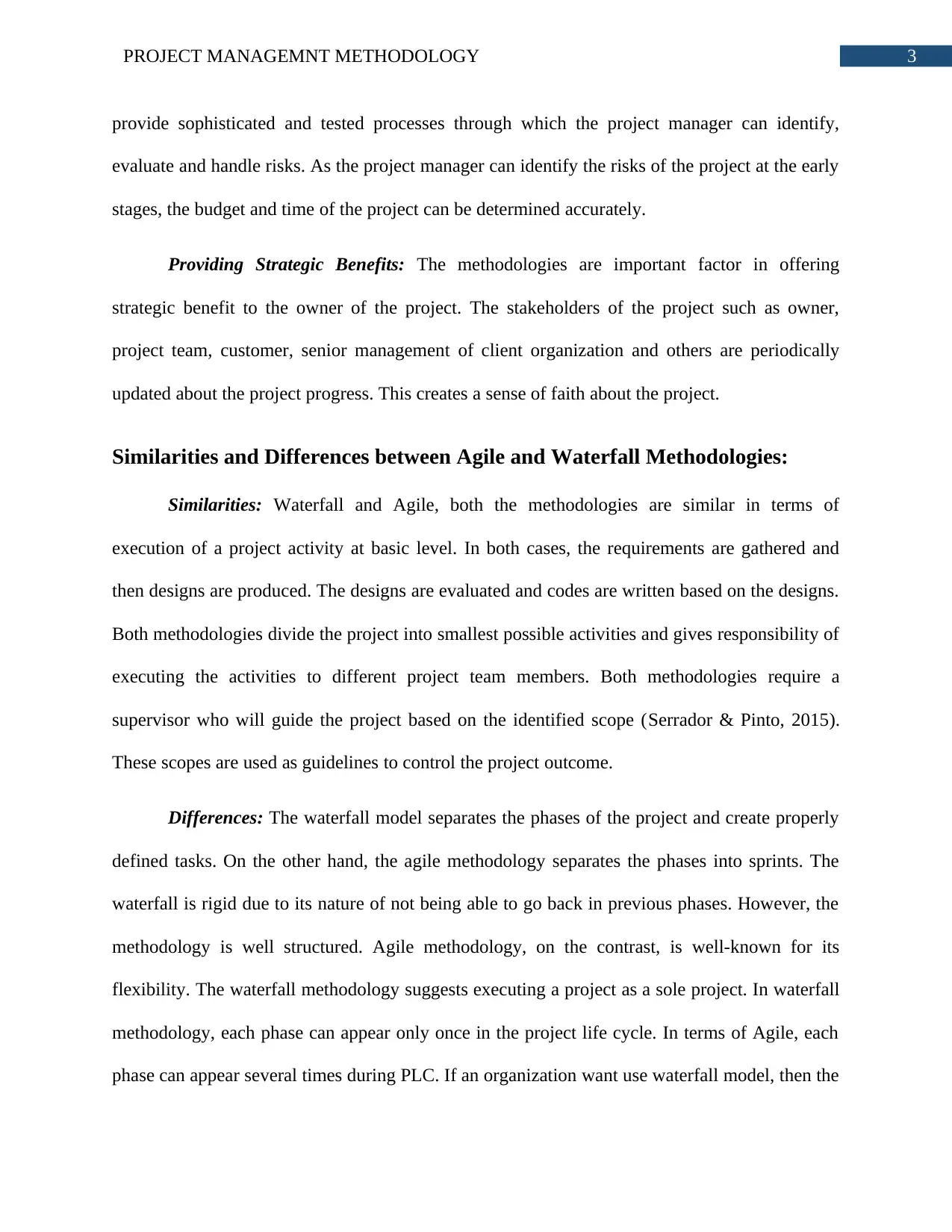
3PROJECT MANAGEMNT METHODOLOGY
provide sophisticated and tested processes through which the project manager can identify,
evaluate and handle risks. As the project manager can identify the risks of the project at the early
stages, the budget and time of the project can be determined accurately.
Providing Strategic Benefits: The methodologies are important factor in offering
strategic benefit to the owner of the project. The stakeholders of the project such as owner,
project team, customer, senior management of client organization and others are periodically
updated about the project progress. This creates a sense of faith about the project.
Similarities and Differences between Agile and Waterfall Methodologies:
Similarities: Waterfall and Agile, both the methodologies are similar in terms of
execution of a project activity at basic level. In both cases, the requirements are gathered and
then designs are produced. The designs are evaluated and codes are written based on the designs.
Both methodologies divide the project into smallest possible activities and gives responsibility of
executing the activities to different project team members. Both methodologies require a
supervisor who will guide the project based on the identified scope (Serrador & Pinto, 2015).
These scopes are used as guidelines to control the project outcome.
Differences: The waterfall model separates the phases of the project and create properly
defined tasks. On the other hand, the agile methodology separates the phases into sprints. The
waterfall is rigid due to its nature of not being able to go back in previous phases. However, the
methodology is well structured. Agile methodology, on the contrast, is well-known for its
flexibility. The waterfall methodology suggests executing a project as a sole project. In waterfall
methodology, each phase can appear only once in the project life cycle. In terms of Agile, each
phase can appear several times during PLC. If an organization want use waterfall model, then the
provide sophisticated and tested processes through which the project manager can identify,
evaluate and handle risks. As the project manager can identify the risks of the project at the early
stages, the budget and time of the project can be determined accurately.
Providing Strategic Benefits: The methodologies are important factor in offering
strategic benefit to the owner of the project. The stakeholders of the project such as owner,
project team, customer, senior management of client organization and others are periodically
updated about the project progress. This creates a sense of faith about the project.
Similarities and Differences between Agile and Waterfall Methodologies:
Similarities: Waterfall and Agile, both the methodologies are similar in terms of
execution of a project activity at basic level. In both cases, the requirements are gathered and
then designs are produced. The designs are evaluated and codes are written based on the designs.
Both methodologies divide the project into smallest possible activities and gives responsibility of
executing the activities to different project team members. Both methodologies require a
supervisor who will guide the project based on the identified scope (Serrador & Pinto, 2015).
These scopes are used as guidelines to control the project outcome.
Differences: The waterfall model separates the phases of the project and create properly
defined tasks. On the other hand, the agile methodology separates the phases into sprints. The
waterfall is rigid due to its nature of not being able to go back in previous phases. However, the
methodology is well structured. Agile methodology, on the contrast, is well-known for its
flexibility. The waterfall methodology suggests executing a project as a sole project. In waterfall
methodology, each phase can appear only once in the project life cycle. In terms of Agile, each
phase can appear several times during PLC. If an organization want use waterfall model, then the
Paraphrase This Document
Need a fresh take? Get an instant paraphrase of this document with our AI Paraphraser
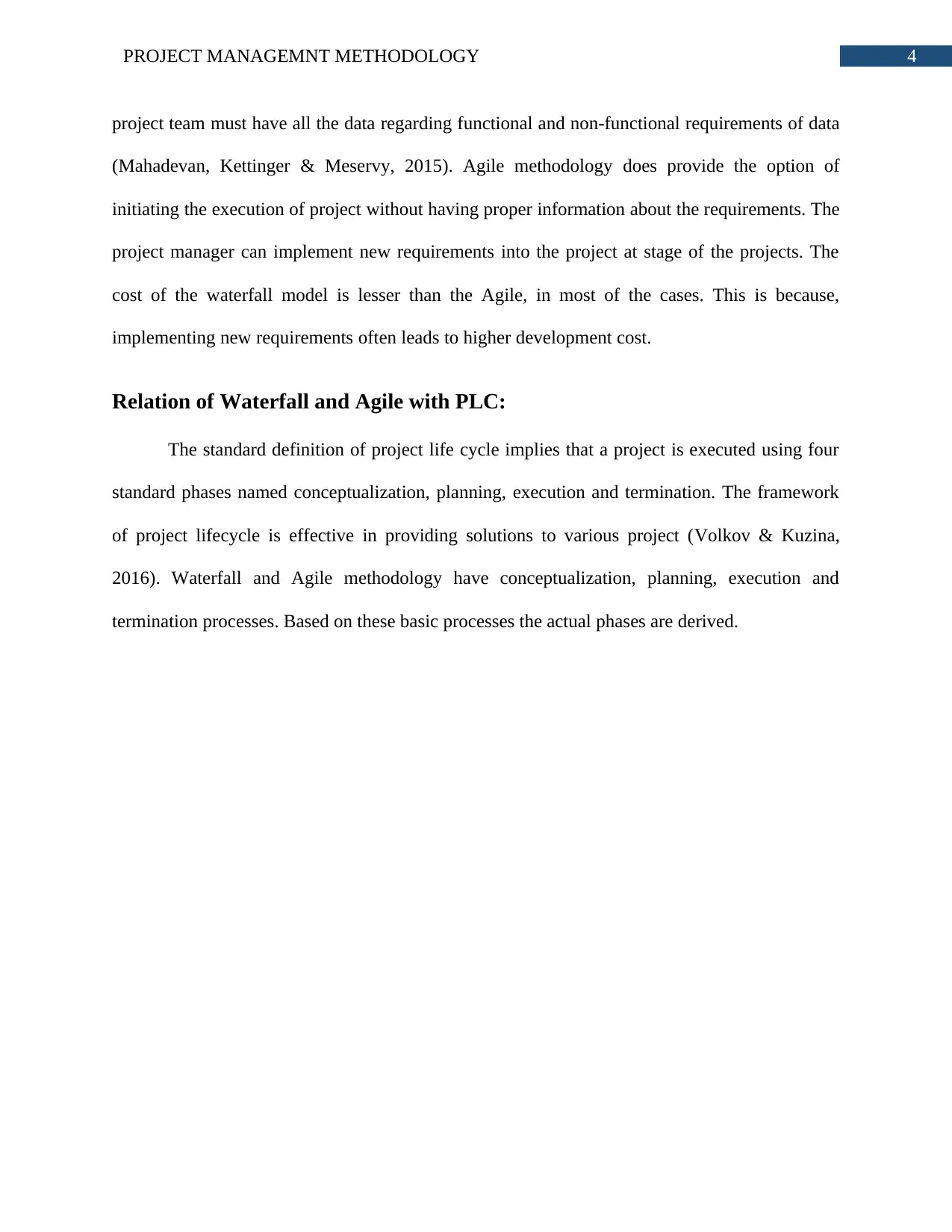
4PROJECT MANAGEMNT METHODOLOGY
project team must have all the data regarding functional and non-functional requirements of data
(Mahadevan, Kettinger & Meservy, 2015). Agile methodology does provide the option of
initiating the execution of project without having proper information about the requirements. The
project manager can implement new requirements into the project at stage of the projects. The
cost of the waterfall model is lesser than the Agile, in most of the cases. This is because,
implementing new requirements often leads to higher development cost.
Relation of Waterfall and Agile with PLC:
The standard definition of project life cycle implies that a project is executed using four
standard phases named conceptualization, planning, execution and termination. The framework
of project lifecycle is effective in providing solutions to various project (Volkov & Kuzina,
2016). Waterfall and Agile methodology have conceptualization, planning, execution and
termination processes. Based on these basic processes the actual phases are derived.
project team must have all the data regarding functional and non-functional requirements of data
(Mahadevan, Kettinger & Meservy, 2015). Agile methodology does provide the option of
initiating the execution of project without having proper information about the requirements. The
project manager can implement new requirements into the project at stage of the projects. The
cost of the waterfall model is lesser than the Agile, in most of the cases. This is because,
implementing new requirements often leads to higher development cost.
Relation of Waterfall and Agile with PLC:
The standard definition of project life cycle implies that a project is executed using four
standard phases named conceptualization, planning, execution and termination. The framework
of project lifecycle is effective in providing solutions to various project (Volkov & Kuzina,
2016). Waterfall and Agile methodology have conceptualization, planning, execution and
termination processes. Based on these basic processes the actual phases are derived.
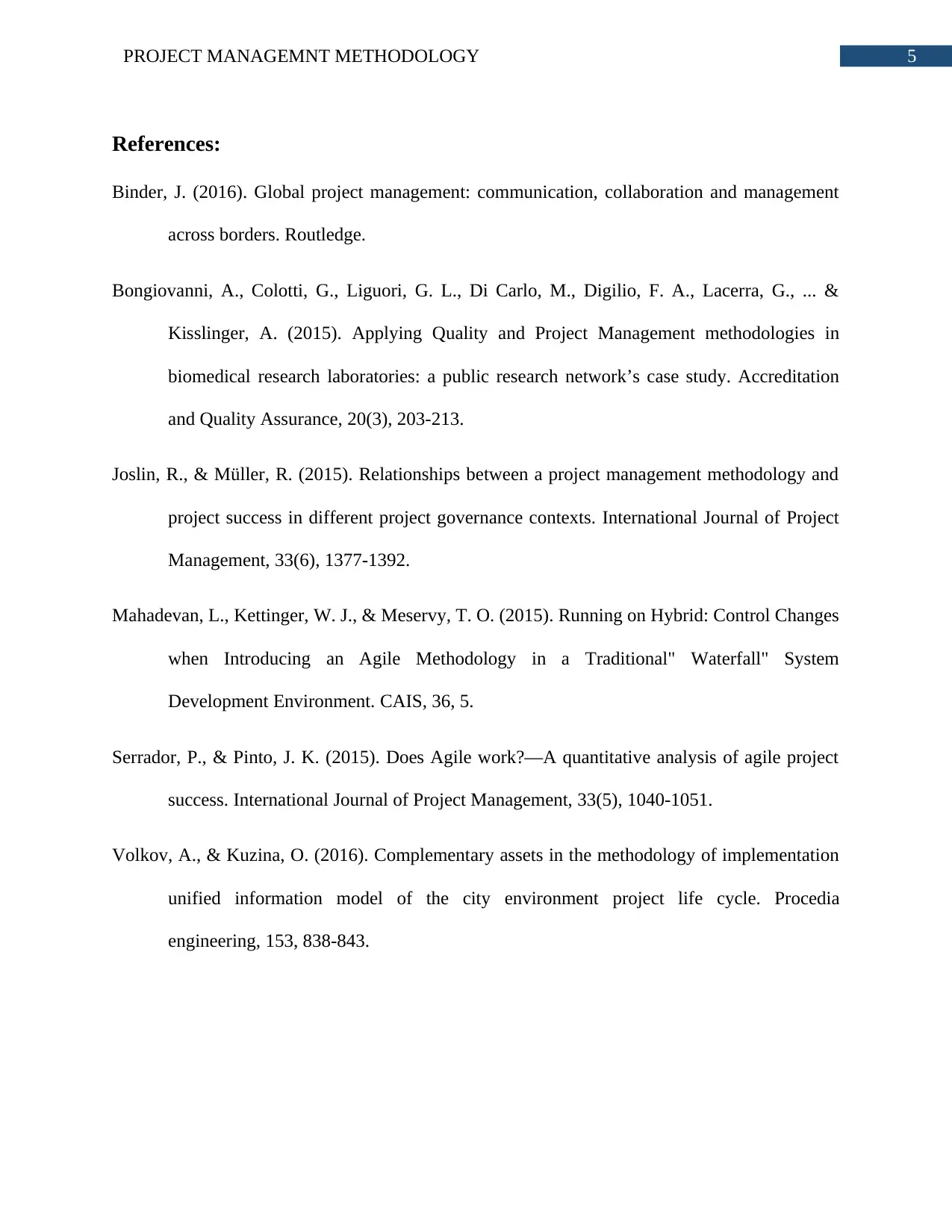
5PROJECT MANAGEMNT METHODOLOGY
References:
Binder, J. (2016). Global project management: communication, collaboration and management
across borders. Routledge.
Bongiovanni, A., Colotti, G., Liguori, G. L., Di Carlo, M., Digilio, F. A., Lacerra, G., ... &
Kisslinger, A. (2015). Applying Quality and Project Management methodologies in
biomedical research laboratories: a public research network’s case study. Accreditation
and Quality Assurance, 20(3), 203-213.
Joslin, R., & Müller, R. (2015). Relationships between a project management methodology and
project success in different project governance contexts. International Journal of Project
Management, 33(6), 1377-1392.
Mahadevan, L., Kettinger, W. J., & Meservy, T. O. (2015). Running on Hybrid: Control Changes
when Introducing an Agile Methodology in a Traditional" Waterfall" System
Development Environment. CAIS, 36, 5.
Serrador, P., & Pinto, J. K. (2015). Does Agile work?—A quantitative analysis of agile project
success. International Journal of Project Management, 33(5), 1040-1051.
Volkov, A., & Kuzina, O. (2016). Complementary assets in the methodology of implementation
unified information model of the city environment project life cycle. Procedia
engineering, 153, 838-843.
References:
Binder, J. (2016). Global project management: communication, collaboration and management
across borders. Routledge.
Bongiovanni, A., Colotti, G., Liguori, G. L., Di Carlo, M., Digilio, F. A., Lacerra, G., ... &
Kisslinger, A. (2015). Applying Quality and Project Management methodologies in
biomedical research laboratories: a public research network’s case study. Accreditation
and Quality Assurance, 20(3), 203-213.
Joslin, R., & Müller, R. (2015). Relationships between a project management methodology and
project success in different project governance contexts. International Journal of Project
Management, 33(6), 1377-1392.
Mahadevan, L., Kettinger, W. J., & Meservy, T. O. (2015). Running on Hybrid: Control Changes
when Introducing an Agile Methodology in a Traditional" Waterfall" System
Development Environment. CAIS, 36, 5.
Serrador, P., & Pinto, J. K. (2015). Does Agile work?—A quantitative analysis of agile project
success. International Journal of Project Management, 33(5), 1040-1051.
Volkov, A., & Kuzina, O. (2016). Complementary assets in the methodology of implementation
unified information model of the city environment project life cycle. Procedia
engineering, 153, 838-843.
⊘ This is a preview!⊘
Do you want full access?
Subscribe today to unlock all pages.

Trusted by 1+ million students worldwide
1 out of 6
Related Documents
Your All-in-One AI-Powered Toolkit for Academic Success.
+13062052269
info@desklib.com
Available 24*7 on WhatsApp / Email
![[object Object]](/_next/static/media/star-bottom.7253800d.svg)
Unlock your academic potential
Copyright © 2020–2025 A2Z Services. All Rights Reserved. Developed and managed by ZUCOL.

